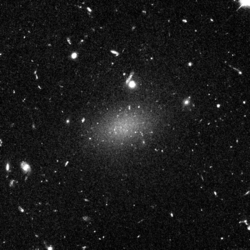Astronomy:Dragonfly 44
| Dragonfly 44 | |
|---|---|
 Hubble Space Telescope view of the galaxy Dragonfly 44 | |
| Observation data (J2000 epoch) | |
| Constellation | Coma Berenices |
| Right ascension | 13h 00m 58.0s[1] |
| Declination | +26° 58′ 35″[1] |
| Redshift | ~0.023 |
| Helio radial velocity | 6280 ± 120 km/s |
| Distance | ~100 Mpc (~330 Mly) |
| Group or cluster | Coma Cluster |
| Apparent magnitude (V) | 21 mags; or 19.4 mags [2] |
| Apparent magnitude (B) | 22 |
| Absolute magnitude (V) | -16.1 mag [2] |
| Characteristics | |
| Mass | ~1.6×1011 M☉ |
| Apparent size (V) | 10 x 35 arcsec |
| Other designations | |
| SDSS J130057.98+265839.6, SDSS J130058.17+265836.1, SDSS J130058.21+265829.3 | |
Dragonfly 44 is an ultra diffuse galaxy in the Coma Cluster.[1][3][2][4] This galaxy is well-known because observations of the velocity dispersion in 2016 suggested a mass of about one trillion solar masses, about the same as the Milky Way. This mass was consistent with a count of about 90 and 70 globular clusters observed around Dragonfly 44 in two different studies.
Later, spatially resolved kinematics measured a mass of about 160 billion solar masses, six times less than early mass measurements and one order of magnitude less than the Milky Way's mass.[5] The most recent work found 20 globular clusters around the galaxy, which is consistent with the current mass measurement.[6][7] The lack of X-ray emission from the galaxy and its surroundings also shows that the number of globular clusters cannot be as many as was claimed before.[8]
The galaxy emits only 1% of the light emitted by the Milky Way.[9] The galaxy was discovered with the Dragonfly Telephoto Array.[10]
Early study
To determine the amount of dark matter in this galaxy, in 2016, astronomers used the DEIMOS instrument installed on Keck II to measure the velocities of stars for 33.5 hours for six nights so they could determine the galaxy's mass. The scientists then used the Gemini Multi-Object Spectrograph on the 8-m Gemini North telescope to reveal a halo of spherical clusters of stars around the galaxy's core.[11]Following this observation, in August 2016, astronomers reported that this galaxy might be made almost entirely of dark matter.[12][13][14]
See also
- Low Surface Brightness galaxy (LSB galaxy)
- NGC 1052-DF2 – a galaxy thought to contain almost no dark matter.
- Type-cD galaxy or c-Diffuse galaxy type
- Type-D galaxy or Diffuse-type galaxy
- Astronomy:DGSAT I – Ultra diffuse galaxy in the Perseus–Pisces Supercluster
References
- ↑ Jump up to: 1.0 1.1 1.2 Van Dokkum, Pieter (7 January 2015). "Forty-Seven Milky Way-sized, Extremely Diffuse Galaxies in the Coma-Cluster". The Astrophysical Journal Letters 798 (2): L45. doi:10.1088/2041-8205/798/2/L45. Bibcode: 2015ApJ...798L..45V.
- ↑ Jump up to: 2.0 2.1 2.2 Van Dokkum, Pieter (1 May 2015). "Spectroscopic confirmation of the existence of large, diffuse galaxies in the coma cluster". The Astrophysical Journal Letters 804 (1): L26. doi:10.1088/2041-8205/804/1/L26. Bibcode: 2015ApJ...804L..26V.
- ↑ "Scientists discover the fluffiest galaxies". phys.org. 14 May 2015. http://phys.org/news/2015-05-scientists-fluffiest-galaxies.html.
- ↑ "Dragonfly 44: Ultra-Diffuse Galaxy Made Mostly of Dark Matter". Sci.News. 25 August 2016. http://www.sci-news.com/astronomy/dragonfly-44-ultra-diffuse-galaxy-dark-matter-04135.html.
- ↑ Van Dokkum, Pieter; Wasserman, Asher; Danieli, Shany; Abraham, Roberto; Brodie, Jean; Conroy, Charlie; Forbes, Duncan A.; Martin, Christopher et al. (2019). "Spatially Resolved Stellar Kinematics of the Ultra-diffuse Galaxy Dragonfly 44. I. Observations, Kinematics, and Cold Dark Matter Halo Fits, Peter van Dokkum et al. 2019" (in en). The Astrophysical Journal 880 (2): 91. doi:10.3847/1538-4357/ab2914.
- ↑ Saifollahi, Teymoor; Trujillo, Ignacio; Beasley, Michael A.; Peletier, Reynier F.; Knapen, Johan H. (2020). ""The number of globular clusters around the iconic UDG DF44 is as expected for dwarf galaxies", Saifollahi et al. 2020". Monthly Notices of the Royal Astronomical Society 502 (4): 5921–5934. doi:10.1093/mnras/staa3016. https://academic.oup.com/mnras/advance-article-abstract/doi/10.1093/mnras/staa3016/5919454?redirectedFrom=fulltext.
- ↑ "The puzzle of the strange galaxy made of 99.99% dark matter is solved". Instituto de Astrofísica de Canarias. 13 October 2020. https://www.iac.es/en/outreach/news/puzzle-strange-galaxy-made-9999-dark-matter-solved.
- ↑ Bogdan, Akos (2020). ""The American Astronomical Society, find out more The Institute of Physics, find out more The Archetypal Ultra-diffuse Galaxy, Dragonfly 44, Is not a Dark Milky Way", Bogdan 2020". The Astrophysical Journal Letters. doi:10.3847/2041-8213/abb886.
- ↑ Crosswell, Ken (26 July 2016). "The Milky Way's dark twin revealed". Nature News. http://www.nature.com/news/the-milky-way-s-dark-twin-revealed-1.20333.
- ↑ Rachel Feltman (25 August 2016). "A new class of galaxy has been discovered, one made almost entirely of dark matter". The Washington Post. https://www.washingtonpost.com/news/speaking-of-science/wp/2016/08/25/a-new-class-of-galaxy-has-been-discovered-one-made-almost-entirely-of-dark-matter/.
- ↑ Byrd, D. (30 August 2016). "A galaxy made of 99.9% dark matter". EarthSky Communications. https://earthsky.org/space/dragonfly-44-dark-matter-galaxy-2016.
- ↑ Van Dokkum, Pieter (25 August 2016). "A High Stellar Velocity Dispersion and ~100 Globular Clusters For The Ultra-Diffuse Galaxy Dragonfly 44". The Astrophysical Journal Letters 828 (1): L6. doi:10.3847/2041-8205/828/1/L6. Bibcode: 2016ApJ...828L...6V. http://scholarworks.sjsu.edu/physics_astron_pub/174.
- ↑ Hall, Shannon (25 August 2016). "Ghost galaxy is 99.99 per cent dark matter with almost no stars". New Scientist. https://www.newscientist.com/article/2102584-ghost-galaxy-is-99-99-per-cent-dark-matter-with-almost-no-stars/.
- ↑ Feltman, Rachael (26 August 2016). "A new class of galaxy has been discovered, one made almost entirely of dark matter". The Washington Post. https://www.washingtonpost.com/news/speaking-of-science/wp/2016/08/25/a-new-class-of-galaxy-has-been-discovered-one-made-almost-entirely-of-dark-matter.
External links
 |

